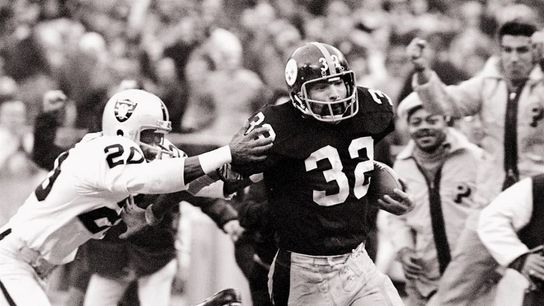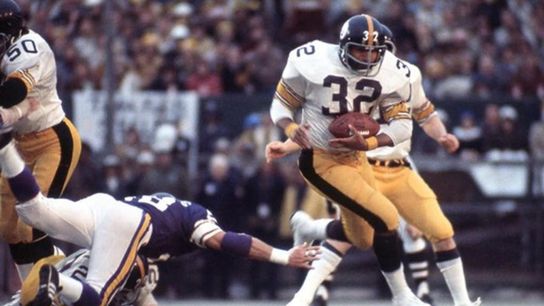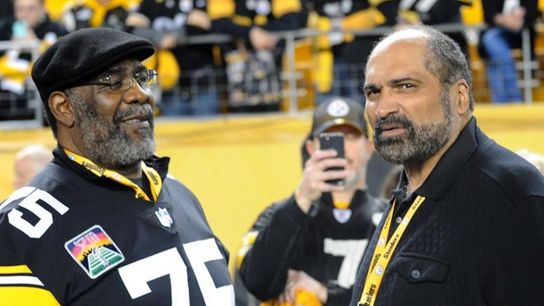The Pittsburgh Steelers jump started their Super Bowl success in 1969 by selecting Joe Greene in the first round of the 1969 NFL Draft and Terry Bradshaw in the 1970 NFL Draft. Greene became the anchor to the greatest defense of all-time and Bradshaw led the team throughout the 1970’s, winning two Super Bowl MVP’s. However, the Steelers did not make the playoffs until 1972 after drafting a fullback from Penn State in the first round of that year’s draft. That fullback was Franco Harris and the Steelers organization decided they were going to convert Harris to halfback. It was a gamble to be sure and would never happen in the modern NFL, but the game was different in the 1970’s and the Steelers wanted a workhorse. They got one with the 13th overall pick hitting pay-dirt.
Harris became the catalyst for the Steelers dynasty. He started 10 games in a 14-game season and set the team’s rookie rushing record that stood for nearly 50 years with 188 rushes for 1,055 yards and a 5.6 YPC attempt. Najee Harris broke it in 2021 with 307 rushes in 17 games and 1,200 yards, averaging 3.9 yards per carry. Both were the unquestioned RB1 in their respective backfields for playoff teams. However, [Franco] Harris transformed the Steelers offense, and the team went 11-3, winning the AFC Central Division for what would be the first of seven division titles of the remaining eight seasons in the decade. Harris won the AP Rookie of the Year, made the Pro Bowl and was Second Team All-Pro. He also finished in the top 10 for MVP and fifth in the Offensive Player of the Year voting. The Steelers first division title and second playoff appearance in franchise history were huge accomplishments for the rookie running back, but he saved his best for the playoffs.

Credit: Pittsburgh Post-Gazette
In the 1972 Divisional Round of the AFC Playoffs, the Steelers hosted the Oakland Raiders on Saturday, December 23rd, 1973. The game was a defensive slugfest in the first half with the teams exchanging punts as Daryle Lamonica and Bradshaw could not move the ball. In the third quarter, Roy Gerela finally got the Steelers on the board with an 18-yard field goal to go up 3-0. Early in the fourth quarter, Gerela hit a 29-yard field goal to put the Steelers up 6-0 until Ken Stabler on in relief of Lamonica, scrambled 30 yards for what seemed to be the winning touchdown based on how both defenses had played all game long with just 1:17 remaining. The situation was bleak for Bradshaw and the Steelers and the stories of what a bright future the Steelers had after making the playoffs for the second time in their history were being written in the press box. Bradshaw and the Steelers stalled at the 40-yard line and on fourth and 10, Bradshaw heaved a prayer to John "Frenchy" Fuqua and Jack Tatum made the play to end the Steelers season by deflecting the ball away -- or so everyone thought.
The ball never touched the ground, and the Steelers Rookie of the Year Harris plucked the ball out of the air and bolted 60 yards for the winning score with no time remaining. The fans waited with bated breath as no signal was officially made while the referees huddled. Legend goes that Fred Swearingen, and his crew were not officially sure what the proper call was supposed to be, so as fans rushed onto the field, he grabbed his crew and asked them:
"Head linesman Al Sabata, line judge Royal Cathcart and field judge Charlie Musser didn’t know who touched the ball last. Pat Harder, the umpire, said, ‘I think the defense hit it.’ Adrian Burk, the back judge, said, ‘Well, I think the defense hit it, too,' said Swearingen. "I asked them a direct question: ‘Are you sure?’ and they both said, ‘No.’ OK, so I’ve got three guys who said, ‘I don’t know’ and two who said, ‘I think.’ Of course, I didn’t see the play, so how am I going to make a decision?"
Swearingen then got on the phone with Art McNally who happened to be at the game in the press box in the dugout of Three Rivers Stadium and a moment later, emerged and signaled touchdown. God had answered Steeler Nation’s prayers and the Immaculate Reception, the greatest play in NFL history, was officially a touchdown. The Steelers would fall the following week 21-17 to the undefeated Miami Dolphins team, but they cemented themselves as a contender thanks to Harris and the defeat of the Raiders. Just two seasons later, the Steelers would win the first of four Super Bowls in six seasons defeating the Minnesota Vikings 16-6 in Super Bowl IX. Harris ran wild in his first Super Bowl appearance and rushed for 158 of what would eventually become 354 yards rushing in four Super Bowls, which is still the career record for rushing yards in the Super Bowl. A record that is unlikely to ever be broken. Harris won the MVP of Super Bowl IX and made his third of what would be nine consecutive Pro Bowl appearances.

Steelers.com
Harris would go on to lead the Steelers in rushing through the 1970’s and aside from an injury shortened season in 1973, exceeded 1,000 yards rushing seven of his first eight seasons. After missing three games to injury in 1980 and losing his six consecutive 1,000-yard seasons streak, he came within 13 yards in 1981 for the black and gold of hitting the mark. 1982 was a strike-shortened year, but in his final full season for the Steelers, he rushed for 1,007 yards. Harris was at 11,950 yards and Jim Brown engaged him in a war of words, as he approached what had seemed like an unbreakable record. Brown was quick to point out that he only played 12 game seasons, and while Harris elected to play in Seattle in 1984 instead of retiring, he only gained 170 yards to finish at 12,120 yards rushing. Brown would not let it go and after badgering Harris all during the 1984 season, they engaged in a made for TV event pitting the 48-year-old Brown against the 34-year-old Harris. The players competed in four events and the 48-year-old Brown beat Harris in a one-on-one basketball games and racquetball game. Harris defeated Brown in a one-on-one football game which featured Phil Simms as the quarterback for both sides and of course the main event, a 40-yard dash which Harris won handily as Brown pulled up with a hurt hamstring. After insisting he was the better athlete incessantly, Brown was classy in defeat:
“Franco beat me fair and square,” said Brown, who grabbed his left hamstring during the dash. “I don’t have any excuses.”
The emphasis on the passing game in today’s NFL with running backs becoming players to be used and discarded before a second contract has deemphasized what was once the premier position in the NFL. Quarterbacks were always important, but during the 1970’s, most teams did not throw the ball 20 times a game. Brown, Paul Hornung, Jim Taylor, Larry Csonka, Earl Campbell and Walter Payton were all more important than the quarterbacks handing them the ball and they were the stars of the era along with Harris. 50 years later, the debate about great offensive players for the Steelers revolves around Bradshaw and Ben Roethlisberger, and Antonio Brown vs Hines Ward.
The greatest offensive player in Steelers history is Franco Harris and I don’t think it is particularly close.
What do you think, Steeler Nation? Has the pass happy NFL forgotten the contributions of Harris? Please comment below or on my Twitter @thebubbasq.


